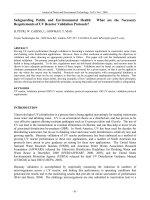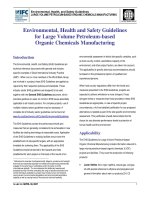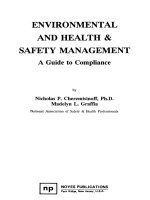- Trang chủ >>
- Khoa Học Tự Nhiên >>
- Vật lý
nanotechnology. health and environmental risks, 2008, p.194
Bạn đang xem bản rút gọn của tài liệu. Xem và tải ngay bản đầy đủ của tài liệu tại đây (5.09 MB, 194 trang )
Nanotechnology
Health and
Environmental Risks
53639.indb 1 3/25/08 3:23:13 PM
/ < = : / - > 3 @ / = 3 8 + 8 9 > / - 2 8 9 6 9 1 C
Series Editor
Gabor L. Hornyak
Nanotechnology: The Business, Michael T. Burke
Nanotechnology: Education and Workforce Development, Gabor L. Hornyak
Nanotechnology: Ethics and Society, Deb Bennett-Woods
Nanotechnology: Health and Environmental Risks, Jo Anne Shatkin
Nanotechnology: Legal Aspects, Patrick M. Boucher
53639.indb 2 3/25/08 3:23:13 PM
Jo Anne Shatkin
Nanotechnology
Health and
Environmental Risks
CRC Press is an imprint of the
Taylor & Francis Group, an informa business
Boca Raton London New York
53639.indb 3 3/25/08 3:23:13 PM
CRC Press
Taylor & Francis Group
6000 Broken Sound Parkway NW, Suite 300
Boca Raton, FL 33487‑2742
© 2008 by Taylor & Francis Group, LLC
CRC Press is an imprint of Taylor & Francis Group, an Informa business
No claim to original U.S. Government works
Printed in the United States of America on acid‑free paper
10 9 8 7 6 5 4 3 2 1
International Standard Book Number‑13: 978‑1‑4200‑5363‑0 (Softcover)
This book contains information obtained from authentic and highly regarded sources Reason‑
able efforts have been made to publish reliable data and information, but the author and publisher
cannot assume responsibility for the validity of all materials or the consequences of their use. The
Authors and Publishers have attempted to trace the copyright holders of all material reproduced
in this publication and apologize to copyright holders if permission to publish in this form has not
been obtained. If any copyright material has not been acknowledged please write and let us know so
we may rectify in any future reprint
Except as permitted under U.S. Copyright Law, no part of this book may be reprinted, reproduced,
transmitted, or utilized in any form by any electronic, mechanical, or other means, now known or
hereafter invented, including photocopying, microfilming, and recording, or in any information
storage or retrieval system, without written permission from the publishers.
For permission to photocopy or use material electronically from this work, please access www.
copyright.com ( or contact the Copyright Clearance Center, Inc. (CCC)
222 Rosewood Drive, Danvers, MA 01923, 978‑750‑8400. CCC is a not‑for‑profit organization that
provides licenses and registration for a variety of users. For organizations that have been granted a
photocopy license by the CCC, a separate system of payment has been arranged.
Trademark Notice: Product or corporate names may be trademarks or registered trademarks, and
are used only for identification and explanation without intent to infringe.
Library of Congress Cataloging‑in‑Publication Data
Shatkin, Jo Anne.
Nanotechnology : health and environmental risks / Jo Anne Shatkin.
p. ; cm. ‑‑ (Perspectives in nanotechnology)
Includes bibliographical references and index.
ISBN 978‑1‑4200‑5363‑0 (hardback : alk. paper)
1. Nanotechnology‑‑Risk assessment. 2. Nanotechnology‑‑Health aspects. 3.
Nanotechnology‑‑Environmental aspects. I. Title. II. Series.
[DNLM: 1. Nanotechnology. 2. Risk Assessment. 3. Environmental
Pollutants‑‑toxicity. 4. Occupational Exposure‑‑adverse effects. QT 36.5 S533n
2008]
T174.7.S52 2008
620’.5‑‑dc22 2007049980
Visit the Taylor & Francis Web site at
and the CRC Press Web site at
53639.indb 4 3/25/08 3:23:14 PM
v
Contents
List of Figures and Tables vii
Series Foreword .
ix
Preface xiii
Acknowledgments xv
Author xvii
Contributors xix
1 Introduction: Assessing Nanotechnology Health and
Environmental Risks 1
Jo Anne Shatkin
2 Defining Risk Assessment and How It Is Used for
Environmental Protection, and Its Potential Role for
Managing Nanotechnology Risks 21
Jo Anne Shatkin
3 Sustainable Nanotechnology Development Using Risk
Assessment and Applying Life Cycle Thinking 47
Jo Anne Shatkin
4 The State of the Science — Human Health, Toxicology, and
Nanotechnological Risk 63
Brenda E. Barry
5 The State of the Science — Environmental Risks 77
Jo Anne Shatkin
6 NANO LCRA — An Adaptive Screening-Level Life Cycle
Risk Assessment Framework for Nanotechnology 97
Jo Anne Shatkin
7 Alternative Approaches for Life Cycle Risk Assessment
for Nanotechnology and Comprehensive Environmental
Assessment 113
Jo Anne Shatkin and J. Michael Davis
53639.indb 5 3/25/08 3:23:14 PM
vi Contents
8 Current and Proposed Approaches for Managing Risks in
Occupational Environments 129
Brenda E. Barry
9 Ongoing International Efforts to Address Risk Issues for
Nanotechnology 149
Jo Anne Shatkin
Index 161
53639.indb 6 3/25/08 3:23:14 PM
vii
List.of.Figures.and.Tables
Figures
1.1 Schematic of a C60 Buckyball compared to a soccer ball 10
1.2 Side view of a carbon nanotube 11
1.3 Potential exposure pathways for nanomaterials 14
2.1 The four steps of the National Academy of Science Risk
Assessment Framework 30
2.2 Technology assessment using causal chain analysis 31
2.3 President’s Commission framework for environmental health
risk management 34
3.1 Environmental pathways affecting water resources 54
4.1 Carbon nanotube characteristics and potential adverse effects 67
4.2 The five Ds of particle toxicology for nanomaterials 67
6.1 Proposed NANO LCRA framework 103
7.1 Comprehensive environmental assessment framework 121
8.1 Framework for evaluating potential occupational risks from
nanomaterials 138
Tables
Table 5.1 Acute Toxicity of Nanoscale TiO
2
in Aquatic Tests 83
Table 5.2 Estimates of Particle Number and Surface Area per
10 µg/m
3
of Airborne Particles 90
53639.indb 7 3/25/08 3:23:14 PM
53639.indb 8 3/25/08 3:23:14 PM
ix
Series.Foreword
Welcome to the Perspectives in Nanotechnology Series — a group of short,
readable paperback books dedicated to expanding your knowledge about a
new and exciting technology. The book you are about to read involves sub-
ject matter that goes beyond the laboratory and the production line. It is not
about technical details—the book you have taken on board your connecting
ight, commuter train, or bus or to your hotel room involves a specic aspect
of nanotechnology that will have some impact on your life, the welfare of
your family, and the wealth and security of this nation. The degree of this
impact may be unnoticeable, slight, overwhelming, or any place in between
those extremes depending on the specic application, its magnitude, and the
scope of its distribution. Those of us that are able to recognize trends, con-
duct efcient research, plan ahead, and adapt will succeed in a new world
enhanced by nanotechnology. This book in the Perspectives in Nanotechnol-
ogy Series hopefully will act as the catalyst for your fantastic journey.
Each book in the series focuses on a selected aspect of nanotechnology. No
technology exists in a vacuum. All technology is framed within the contexts
of societal interactions, laws, and practices. Once a technology is introduced
to a society, the society must deal with it. The impact of a technology on
culture, politics, education and economics depends on many complex fac-
tors—just reect for a moment on the consequences (good and bad) of the
computer, the automobile or the atomic bomb. Nanotechnology is designated
to be the “next industrial revolution.” Although there is much hype associ-
ated with nanotechnology, the ability to manipulate atoms and molecules in
order to fabricate new materials and devices that possess remarkable proper-
ties and functions alone should be enough of a hook to draw you in.
The impact of new technology is more relevant than ever. Consider that
our world is highly integrated, communication occurs instantaneously and
that powerful geopolitical and economic pressures are in the process of con-
tinually changing the global landscape. We repeat—the degree of the impact
of nanotechnology may be unnoticeable, slight, overwhelming, or anyplace
in between. Those of us who are able to recognize trends, conduct efcient
research, plan ahead, and adapt will succeed. It is all about survival. It always
has been. Darlene Geis in her book, Dinosaurs and Other Prehistoric Animals,
states:
…and nally even the mighty T-Rex died out, too. His size and strength
and remarkable jaws were of no use to him in a world that was changing
and where his food supply was slowly disappearing. In the end, the king
was no greater than his subjects in a world whose rule has always been
Change with Me–or Perish!
1
53639.indb 9 3/25/08 3:23:15 PM
x Series Foreword
Although stated with a bit of drama, the quotation does bring the point
across quite effectively. Your future is in your hands—perhaps holding this
very book.
S
ocietal. Implications Societal aspects (implications) consist of a broad
family of highly integrated components and forces that merge with tech-
nology to form our civilization. Government, business, academia, and other
social institutions have evolved over millennia and are in a constant state
of dynamic ux. Civilizations change for many reasons. Technology always
has been one of the primary drivers of this change. The change may be ben-
ecial, detrimental, or anywhere in between. From the rst stone implement,
the iron of the Hittites to the microchip, technology has always played a
major role in the shaping of society. Societal implications of nanotechnology
are rooted in the technology. Societal implications in turn have the capacity
to alter any technology. How many times have social forces inspired a new
technology? The technology developed in the space program is one example
of such a relationship—the development of penicillin another.
What exactly are “societal implications”? How do they relate to nanotech-
nology? In this series, we intend to cover a wide variety of topics. Societal
implications of nanotechnology are both numerous and diverse and encom-
pass the legal, ethical, cultural, medical, and environmental disciplines.
National security, education, workforce development, economic policy, pub-
lic policy, public perception, regulation are but a few of the areas we plan
to address in the near future.
2
All aspects of government, business and aca-
demia are subject to the inuence of nanotechnology. All vertical industrial
sectors will be impacted by nanotechnology—aerospace, health care, trans-
portation, electronics and computing, telecommunications, biotechnology,
agriculture, construction and energy. For example, all Fortune 500 compa-
nies already have staked a claim in nanotechnology-based products. Service
industries that focus on intellectual property and technology transfer, health
and safety, environmental management and consulting, workforce sourcing
and job placement, education development and curriculum, and investment
and trading already engage the challenges brought about by nanotechnol-
ogy. There is no lack of subject matter. We plan to cover the most urgent, the
most relevant and the most interesting topics.
Ethical implications are associated with every form of technology. Arti-
cial intelligence, weapon systems, life-extending drugs, surveillance, altered
organisms, and social justice all have built-in moral implications—ready
for us to discuss. Nanotechnology is creating new ethical dilemmas while
simultaneously exacerbating (or alleviating) older ones. Nanotechnology is
already changing our legal system. How does one go about obtaining a pat-
ent of a process or material that is the result of an interdisciplinary collabo-
ration, e.g., the convergence of engineering, chemistry, physics, and biology?
Even more so, the environmental footprint of nanotechnology is expected
to be three orders of magnitude less than that of any current technology.
The health (and environmental) consequences of nanomaterials are mostly
53639.indb 10 3/25/08 3:23:15 PM
Series Foreword xi
unknown. And what of public perception? How many of you want a nano-
tech research center in your back yard (are you a NIMBY)? How should we
update our educational system to accommodate nanotechnological topics?
What should we do to make sure our workforce is current and prepared?
How will your job or career be inuenced by nanotechnology?
There are other relevant questions. How does one go about building a
nanobusiness? What new kinds of partnerships are required to start a busi-
ness and what exactly is the barrier of entry for such an undertaking? What
are nanoeconomic clusters? What Fortune 500 companies and what business
sectors require a book in this Series to describe its NT prole? And what
of investing and funding? What is the status of nanotechnology programs
on the international stage? What about nanotechnology and religion? What
about the future of nanotechnology? The list goes on.
T
he.Books Web resources that address societal implications of nanotech-
nology are plentiful but offer usually encapsulated or cursory information.
On the other hand, comprehensive (but tedious) summary reports produced
by research and marketing rms are suitable for the serious investor but
require a major nancial commitment to procure and therefore, are gen-
erally not available to the public at large. In addition, government entities,
e.g., the National Nanotechnology Initiative (), have
generated comprehensive reports on the societal impact of NT.
1,2
Such docu-
ments, although excellent, are generally not well known to the public sector.
A reader-friendly, affordable book with commercial appeal that targets the
nanoaware (as well as the unaware) layperson or expert in the eld offers a
convenient alternative to the options listed above.
The intent of each book is to be informative, compelling, and relevant. The
books, in general, adhere to the criteria listed below.
Readability. Each book is 200 to 300 pages long, with an easy to read
font and is abundant with non-technical but certainly non-ponder-
ous language.
References. Each book is well researched and provides links to more
detailed sources when required.
E
conomical pricing. Each book is priced within easy reach and
designed for accelerated distribution at conferences and other
venues.
S
ubject matter. The subject of each book is relevant to nanotechnol-
ogy and represents the cutting-edge in the state-of-the-art.
Relevance. The books are dynamic. We must stay current if we are
to abide by T-Rex’s rule! Specically, the content will stay relevant
in the form of future editions as the climate of nanotechnology is
expected to change dynamically over the years to come. A strong
temporal component is inherent in the Perspectives in Nanotechnol-
ogy Series.
•
•
•
•
•
53639.indb 11 3/25/08 3:23:15 PM
xii Series Foreword
It is our hope that readers delve into a book about their special interest but
also to transform themselves into a state of nano-readiness. Are you nanoready?
Do you want to be able to recognize the drivers that surround nanotechnol-
ogy and its potential promise? Do you want to be able to learn about the sci-
ence, technology and potential implications? Are ready at this time to plan
and adapt to changes? Do you want to become an agent of change? Do you
want success in that future? If your answers are, in order—NO, YES, YES,
NO, YES, and YES—you are ready to begin reading this book.
Gabor L. Hornyak
Series Editor
References
1. D. Geis, Dinosaurs and Other Prehistoric Animals, Grosset & Dunlap, New York
(1959).
2
. M.C. Roco and W.S. Bainbridge, Eds., Societal Implications of Nanoscience and
Nanotechnology, National Science Foundation, Arlington, Virginia (2001).
3
. M.C. Roco and W.S. Bainbridge, Eds., Nanotechnology: Societal Implications—
Maximizing Benets for Humanity, Report of the National Nanotechnology Ini-
tiative Workshop, December 2–3 (2003).
53639.indb 12 3/25/08 3:23:15 PM
xiii
Preface
Technology is a powerful force of change in our world. We live longer and
arguably better lives than our great-great-grandparents because of advances
in medical, communication, and transportation technology. As we enter this
new century there is apparently no end in sight for the transformative poten-
tial of human innovation. However, there is now ample evidence that the
real legacy of invention is dened in equal parts by its benets to society
as well as its costs. There is no technology that comes without some level of
risk. What this can or should mean for the process of creating and nurturing
emerging technology remains a central question for all of society, one which
this book explores for the emerging area of nanotechnology.
The term ‘nanotechnology’ encompasses a dizzying array of individual
technologies, integrated into products in virtually every industry we can
dene. Nanotechnology can be found in humble products like antibacterial
fabrics, as well as in the memory and computing elements of the latest high-
end computers. What links these very different applications is their reliance
on materials that are designed and shaped with nanometer scale precision.
These systems can possess very special chemical, optical, and magnetic
properties that motivate their use; their size—from one to one hundred
nanometers—can also be a great advantage for engineering design. Some
nanoparticles, for example, can mix with and penetrate both solid and liq-
uid media normally impermeable to larger size particulates. The small size,
chemical reactivity, and tunable properties together drive their use across a
wide swath of products.
These same features, when considered through the lens of risk assessment,
drive a different set of concerns about nanomaterial safety. Some unbound
nanoparticles are often engineered for persistence, high chemical reactivity,
and can be found in a wide set of products and thus a wide set of exposure
conditions. It is reasonable, but not yet proven, that given the sheer number
of nanoparticle types and possible exposures there exists some potential for
unwanted environmental impacts. The technical data that could prove or
disprove this hypothesis are still incomplete, and the best practices for gen-
erating such information are just now being claried. Regulatory policy is
still evolving but the early signs in several countries indicate a watchful, but
not overly cautious stance. It is in this climate of uncertainty and optimism
that nanotechnology is taking its rst steps into commercial products.
Whether these steps lead to a sustainable and secure industry depends
in large part on how well all stakeholders participate in dening and man-
aging nanotechnology’s risks. Researchers, policymakers, industry leaders,
and consumers must make difcult decisions about the pace and direction of
nanotechnology’s commercialization. They must discuss, disagree, and even-
tually nd a common path that navigates between innovation and caution.
53639.indb 13 3/25/08 3:23:15 PM
xiv Preface
Central to this decision making process is risk assessment. Contributions
such as this one provide an updated view of risk assessment and manage-
ment practices that accounts for the quirks and complexities that are unique
to products of nanotechnology. Ultimately, such information can help ensure
that the examination and dialog about nanotechnology’s risks can occur at
the highest possible technical level.
53639.indb 14 3/25/08 3:23:16 PM
xv
Acknowledgments
This book would not have been written without the help and support of
many people. While I cannot possibly name them all, and risk omitting key
people, there are several to acknowledge for their contributions. First, I wish
to thank the talented and organized staff at CRC/Taylor & Francis publish-
ing, especially my publisher Nora Konopka, for envisioning this project and
inviting my participation in it. I also wish to thank series editor Gabor L.
Hornyak and my series co-authors, for the valuable conversations we had in
our early stages of development.
Thanks are due to my co-authors, Brenda Barry and Mike Davis, for their
expertise and insights into the ideas developed in this book, for their respec-
tive contributions, and for their continuing collegiality. Thanks to Vicki
Colvin for her early work that raised my awareness of these issues, and for
contributing the preface.
Thanks especially to Jim Intrater, my dear cousin, for bringing the issue
of nanotechnology risk to my attention. I greatly appreciate the generous
support of my colleagues at the Cadmus Group, who believed in the value of
developing approaches for evaluating nanotechnology risks and encouraged
my pursuit of them, particularly Ian Kline, Gene Fax, G. Tracy Mehan, Jane
Obbagy, and George Hallberg.
I wish to thank numerous colleagues in the elds of colloidal chemistry,
nanoscience, and risk analysis, too many to name individually, who shared
their perspectives and with whom I have had many insightful conversations
about managing nanomaterial, nanotechnology, and other emerging envi-
ronmental risks. In particular, I must acknowledge Bob Hoch, Paul Susman,
Rick Canady, Andrew Maynard, Chris Cooper, Kristen Kulinowski, Clayton
Teague, and Tor Arnesen, who patiently shared both knowledge and wis-
dom that helped me clarify my thinking. I extend appreciation to my Clark
University professors who taught me to examine environmental issues criti-
cally and broadly, notably Halina Brown, Rob Goble, Dale Hattis, Sam Ratick,
and Ortwin Renn. Thanks also to early career mentors Ron Levy, Katherine
Hammond, Charlie Menzie, Susan Vick, and Susan Woskie.
Finally, I wish to express my gratitude to my family for wholeheartedly
supporting me in this endeavor. I thank Chris, who nourished me and left
me alone to write, as well as Josh and Tony—all of whom collectively took
over my share of family responsibilities so I could focus. Thanks also to my
loving friends who steadfastly encouraged me, especially Dori Farrar Read,
an early inuence on environmental issues. I thank my sister Susan Shat-
kin, whose skillful editing made this book readable, and my mother, Evelyn
Shatkin, for her unending encouragement and enduring belief that I can do
anything I set my mind to. I am also indebted to my sister Lenore, to whom I
53639.indb 15 3/25/08 3:23:16 PM
xvi Acknowledgments
dedicate this book, for the many gifts she gave me, in her decurtate, poignant
life on earth.
53639.indb 16 3/25/08 3:23:16 PM
xvii
Author
Dr. Jo Anne Shatkin is a recognized expert in strategic environmental ini-
tiatives, human health risk assessment, technical communications, and envi-
ronmental aspects of nanotechnology. Her work focuses on approaches for
evaluating new and emerging contaminants in the environment, particu-
larly on assessments of chemical and microbial concerns that inform policy
development. Her specialty is the application and communication of innova-
tive science-informed analysis to address complex emerging issues affecting
businesses and communities.
Dr. Shatkin has been an active member of the Society for Risk Analysis
since 1989, and recently founded the Emerging Nanoscale Materials Spe-
cialty Group of the Society for Risk Analysis, with 130 international members
from public and private organizations. She is a research fellow at the George
Perkins Marsh Institute at Clark University. Her research interests include
developing risk-informed management tools for environmental health and
safety evaluations, community-based research, and cumulative risk assess-
ment approaches.
She received her Ph.D. in environmental science and policy in 1994 and her
master’s degree in risk management and technology assessment, both from
Clark University, Worcester, Massachusetts and she possesses a bachelor of
science degree from Worcester Polytechnic University in biology and bio-
technology. She is managing director of CLF Ventures, the non-prot afli-
ate of the Conservation Law Foundation.
53639.indb 17 3/25/08 3:23:16 PM
53639.indb 18 3/25/08 3:23:16 PM
xix
Contributors
Dr. Brenda E. Barry is a senior toxicologist at ENSR in Westford, Massachu-
setts. Her areas of expertise include toxicology, environmental exposure con-
cerns, occupational health and safety, biosafety and nanotechnology. She is a
member of the ENSR Nanotechnology Initiative and the risk assessment and
toxicology group in the Westford ofce. Dr. Barry has been a senior project
manager for numerous indoor and outdoor environmental quality investiga-
tions involving exposures to air pollutants, asbestos, chemicals and microbial
agents. She also previously developed and managed environmental health
and safety programs for biotechnology companies in the New England area.
An accomplished writer and speaker, she has provided expert testimony for
environmental litigation.
Dr. Barry received her doctorate in pathology at Duke University where
her research interests focused on the health effects of exposures to environ-
mental agents, including ozone and asbestos. She received her B.S. in zool-
ogy and M.S. in biophysics from the University of Rhode Island. Dr. Barry
is a member of several professional organizations, including the Society of
Toxicology, the American Biological Safety Association, and the ASTM Inter-
national Committee E56 on Nanotechnology. She is also certied as a regis-
tered biosafety professional.
J. Michael Davis is senior science advisor with the National Center for
Environmental Assessment in the U. S. Environmental Protection Agency’s
Ofce of Research and Development at Research Triangle Park, North Caro-
lina. He received his Ph.D. degree from Duke University in 1973, held post-
doctoral fellowships at the University of Oxford, England and the University
of North Carolina at Chapel Hill and has been with the EPA since 1979. He
has played a major role in the United States and internationally in assessing
the health risks of lead, manganese, MTBE, methanol, and other chemicals
used as fuels or fuel additives, and has led in the formulation of multi-dis-
ciplinary research programs in these areas. His current activities include
the development of a research strategy for the comprehensive environmen-
tal assessment of nanomaterials. Among his recent publications is “How to
assess the risks of nanotechnology: Learning from past experience” in the
Journal of Nanoscience and Nanotechnology (2007).
53639.indb 19 3/25/08 3:23:16 PM
53639.indb 20 3/25/08 3:23:16 PM
1
1
Introduction: Assessing Nanotechnology
Health and Environmental Risks
Jo Anne Shatkin
Exposure to free engineered nanomaterials (as opposed to ne particles
that are naturally occurring or that are the incidental byproducts of
human activities such as combustion or welding) is for the most part still
low. So we are well positioned to assess possible risks before nanopar-
ticles become widely used or make their way into the environment in
large quantities.
E
. Clayton Teague, Director
U
.S. National Nanotechnology Coordination Ofce
Throughout my career, I have been amazed at the tiny risks that people are
really afraid of, and equally amazed at the large risks taken daily — some-
times by the same people — that are so well known and so dangerous. Risk
analysis is a way to put different hazards in perspective, to ensure focus on
the most signicant concerns, which are not necessarily the ones people are
CONTENTS
1.1 What is Nanotechnology? 4
1.1.1 What, Then, is Nanotechnology? 5
1.2 The Roots of Nanotechnology and the Next Industrial Revolution 8
1.3 Nanomaterials: The Current State of Nanotechnology Application 9
1.4 Nanotechnology Risks Now 12
1.5 Environmental Aspects of Nanotechnology 13
1.6 DDT, Learning from the Past 14
1.7 What is Risk? 16
1.8 Risk Analysis 18
1.9 Overview of the Book 18
References 19
53639.indb 1 3/25/08 3:23:17 PM
2 Nanotechnology: Health and Environmental Risks
most vocal about. According to some projections for nanotechnology, every-
one may be affected one way or another as nanomaterials and nanotechnol-
ogy increasingly enter more sectors of the economy. If the projections are
correct, then it is important to gain perspective on potential risks of nano-
technology to inform your decision making — whether you are a developer,
user, investor, consumer, or regulator. This book explores the respective elds
of risk analysis and nanotechnology, and proposes an adaptive framework
for taking on the challenge of risk assessment of this rapidly developing eld
of technology.
Many of the current applications of nanotechnology are in consumer
products. Maybe your MP3 player or the coating on your cell phone uses
nanotechnology. Your laptop screen may use nanotechnology for a stronger,
scratch-resistant coating, or a more energy efcient and higher resolution
display. You could be wearing antimicrobial socks or static-free pants. Your
home may have a self-cleaning toilet (or perhaps you wish it did). You may
be working with nanomaterials in a laboratory.
This book explores questions about the introduction and uses of nanotech-
nology for energy, industry, medicine, technology, and consumer applica-
tions. And how to determine whether there is — and ways to manage the
risk — even if there is no current evidence. Why is there so much attention to
the risks associated with nanotechnology? Why write a book—or read one—
about tiny, tiny risks that may or may not be more than theoretical? Con-
sidered in the context of global environmental and public health concerns
such as global warming, bird u, war, AIDS, malaria, antibiotic resistance, or
nuclear threats, how signicant are the potential risks from nanoscale mate-
rials and nanotechnology? What are the risks from nanotechnology and why
is there seemingly international consensus that signicant resources are nec-
essary to understand and address them?
The unique behavior of substances engineered to sizes 100 nanometers
and smaller (a nanometer is one billionth of a meter) is what makes them
attractive to nanoscientists and engineers for developing new materials and
applications in almost every sector of the world’s economy. The size raises
questions, however, about whether their unique behavior also affects biolog-
ical systems (people and the environment) differently than other materials.
Deoxyribonucleic acid (DNA), the basic building block of life, is made of
molecules that are only a few nanometers in width. Because it is not engi-
neered, DNA may not fall into everyone’s denition of nanoscale materials;
however, a key point is that other nanoparticles and nanoscale materials are
in the same size range as DNA, and perhaps these can react with one another
in ways that larger particles cannot. Simply, it is important to address the
questions of health and environmental risks now, so that nanotechnology can
fulll its promise to improve medical diagnoses and treatment, help address
our energy needs and mitigate global warming, help reduce existing pollu-
tion, and perhaps even provide tools to stem global pandemics. Answering
the questions about health and environmental risks from nanotechnology
raises broader societal implications about managing technology, and whether
53639.indb 2 3/25/08 3:23:17 PM
Introduction: Assessing Nanotechnology Health and Environmental Risks 3
we are up to the task of addressing more complex and integrated changes to
our economy and quality of life.
Evaluating the potential risks early in product development creates an
opportunity to safely manage them. The main reason to address the health
and environmental aspects of nanotechnology is uncertainty. Even while the
behavior of nanomaterials in biological systems is poorly understood, there
are hundreds of products containing nanomaterials on the market today and
many more in the pipeline, including more sophisticated applications that
include active nanostructures that change in response to an external stimu-
lus. Some people are concerned that the uncertainties associated with the
introduction of nanotechnology may create new and unmanageable hazards
to health and to the environment.
There is no reason for technology to develop in an unsustainable manner.
In the past, lack of foresight has yielded staggering costs in terms of lives and
lost use of land — costs to corporations, governments, and individuals — that
could have been avoided by proactive efforts. The tools to develop safer tech-
nologies and less harmful products exist. There exists plenty of experience
that demonstrates how not to proceed. The chemical industry has learned this,
and now participates in voluntary and regulatory efforts to create safer prod-
ucts (e.g., HPV Challenge, Responsible Care). As discussed in Chapter 9, the
electronics industry is also seeking to provide leadership and voluntary initia-
tives to develop nanotechnology safely. Those developing nanoscale materials
and using them in technologies have a responsibility to ensure they do not
harm people’s health or the environment. Governments and many industries
recognize this and have initiated efforts to do so, but the complexities raised
by some of the unique properties of nanomaterials studied to date raise con-
cerns about whether existing risk management approaches make sense, and
there is still uncertainty regarding how to proceed.
The eld of risk analysis has grown enormously in the past four decades
and provides a systematic, coherent, and tested foundation for managing the
uncertain health and environmental aspects of nanotechnology. Years of man-
aging hazardous substances has led to development of sophisticated tools for
evaluating the behavior of materials, and by identifying the needs early, indus-
try and governments can conduct the necessary research and make better
decisions about how to manage nanomaterials, to ensure a safer path forward.
Risk analysis offers the tools to identify and manage risks under uncertainty;
however, the challenge is to adapt it to the rapid stream of developments in
nanotechnology that may affect environmental and health hazards.
Nanotechnology is rapidly becoming the technological future, and there is
an exciting opportunity to design that future. Nanotechnology presents an
opportunity to redesign and to engineer technologies to specication. This
offers the chance to minimize the risks and maximize the benets of tech-
nological innovation. So if it seems a material or technology may be more
hazardous than we are willing to accept, this is an opportunity for inno-
vation — to engineer out the hazard. New materials can be (and increas-
ingly are) designed to be safer (so-called “green manufacturing”) and more
53639.indb 3 3/25/08 3:23:17 PM
4 Nanotechnology: Health and Environmental Risks
environmentally friendly. Risk analysis is a tool to help achieve a sustainable
future with nanotechnology.
Many people within and outside of government are working to ensure the
safety of nanomaterials, to avoid the unintended effects that occurred from
other substances: asbestos, polychlorinated biphenyls (PCBs), DDT, and lead,
for example. These substances were widely used because they offered solu-
tions to many industrial and societal needs, but over decades of use their
impacts on health and the environment began to emerge. While the health
and environmental effects of these substances are among the most studied,
they are still poorly understood, suggesting a different path is needed for
identifying and managing substances going forward.
This book seeks to give the reader some tools and information to help
improve understanding of the health and environmental dimensions of nan-
otechnology. As with other books in the series, this volume is intended to
be accessible to the non-specialist, and explores a breadth of technical and
societal topics relevant to the discussion. This book cannot answer most
questions about the health and environmental risks of nanotechnology; the
answers simply are not known today. But it does provide perspectives about
what types of risks could exist, and what can be done to address them.
1.1 What is Nanotechnology?
Nanotechnology is a scale of technology, not a type, and it has applications
in every economic sector: medicine, energy, industrial applications, materi-
als science, engineering, electronics, communications, cosmetics, additives,
coatings, food science, water purication, and agriculture. Ever Google
“nano”? Today there are 61 million hits — many of which have nothing to
do with nanotechnology, but one nds “nano” everywhere — some of the
discussion is hype about the promise or the perils (for example, an advertise-
ment for a “nano” Hummer H3), and it is important to consider the source of
information. But there are also numerous applications in development that
suggest a brave new technological world — self-assembling materials that
act on demand — not the world of Prey, a science ction novel in which intel-
ligent nanoscale robots take over (Creighton 2002), but of smart technology
that combines information technology with nanotechnology in novel appli-
cations. An example might be a targeted pesticide, released only when a spe-
cic pest appears, triggered by detecting a key protein, rather than routine
spraying of crops.
Nanomaterials have been in commerce for decades, including carbon
nanotubes, rst patented in the 1990s, but the pace seems to be accelerat-
ing now. A database of consumer products containing nanomaterials or
using nanotechnology lists nearly 500 entries of products on the market
today (WWCS 2007), and there are numerous industrial applications that
53639.indb 4 3/25/08 3:23:17 PM









